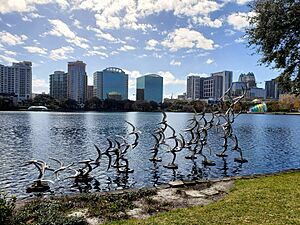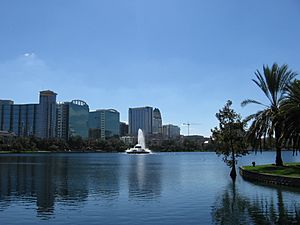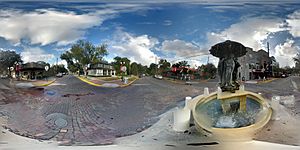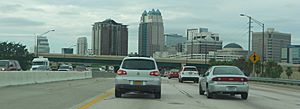Downtown Orlando facts for kids
Quick facts for kids
Downtown Orlando
|
|
|---|---|

Downtown Orlando skyline as seen from Lake Eola facing west
|
|
| Nicknames:
Downtown, Central Business District
|
|
| Country | United States |
| State | Florida |
| County | Orange County |
| City | Orlando |
| Settled | July 31, 1875 |
| Subdistricts of Downtown |
Neighborhoods list
North Quarter
Eola Heights Thornton Park South Eola District Lake Cherokee Historic District Holden/Parramore Central Business District |
| Population
(2010)
|
|
| • Total | 18,731 (Includes all Downtown neighborhoods) |
| • Density | 5,123/sq mi (1,978/km2) |
| Demonym(s) | Downtowner |
| Time zone | UTC-05 (EST) |
Downtown Orlando is the main part of Orlando, Florida, in the United States. It's like the city's historic heart and main business area. It's surrounded by Marks Street to the north, Mills Avenue to the east, Orange Blossom Trail to the west, and Kaley Avenue to the south.
Downtown has many different neighborhoods. These include North Quarter, Lake Eola Heights, South Eola, Thornton Park, Parramore, Lake Cherokee, and the Central Business District. In 2010, about 18,731 people lived in downtown. During the day, this number grew to around 65,000 people.
Contents
What is Downtown Orlando Like?
Downtown Orlando is the biggest city center in Central Florida. It has many tall buildings where people live and work. You'll find local, state, and federal government offices here. It also has sports stadiums, theaters for shows, art galleries, and movie theaters. There are shops, nightclubs, and parks too.
Downtown is different from the tourist areas in the city's southwest. But many visitors come here to see the "Real Orlando." It's also where many festivals, parades, and other big events happen all year long.
Downtown's Neighborhoods
Downtown Orlando has seven official neighborhoods. These are:
- Callahan
- Central Business District
- Holden/Parramore
- Lake Dot
- Lake Eola Heights
- South Eola
- North Quarter
North Quarter: A Lively Spot
The North Quarter is north of Colonial Drive. It's bordered by Interstate 4 to the west and Highland Avenue to the east. This area has grown a lot with new apartments and condos. It's now home to many different shops and restaurants. Because it's so close to the main business area, it's a great place for people who want to live, work, and play in downtown Orlando.
Parramore: A Historic Community
Parramore was started in the 1880s. It's been the center of Orlando's African-American community for a long time. This area is just west of the Central Business District. Leaders in Orlando are working to make the area even better. While some parts have changed, Parramore still keeps its strong African-American identity.
It's a place where people live, but it also has big buildings for entertainment and offices. These include the Amway Center, the Bob Carr Performing Arts Centre, and the Orlando Police Department headquarters. You can also find grocery stores, barber shops, and soul food restaurants here.
Orlando officially sees Parramore as three separate neighborhoods: Lake Dot, Callahan, and Holden/Parramore.
Central Business District: The City's Core
The Central Business District is Orlando's main financial area. It's the most famous part of downtown. Many of Orlando's nightclubs are also found here. You'll see corporate offices for big banks like Wells Fargo and Suntrust. Orlando City Hall, foreign consulates, and many hotels are also in this area.
Church Street Station is a well-known spot here. Many of Orlando's old buildings stand next to modern skyscrapers. The Rogers Building, built in 1886, is the oldest building in downtown Orlando. It was once an English Gentlemen's Club.
Eola: Park and History
Lake Eola Park is east of the Central Business District. Lake Eola Heights is north of the lake, and South Eola is to the east and south. The park is very important to the city's history. It often hosts events and festivals. The most famous part of the park is the Linton E. Allen Memorial Fountain. This fountain is lit up every night with colorful lights and water shows.
You can rent swan boats at the park. There's also the Walt Disney Amphitheater. Every Independence Day, thousands of people come to the park for a huge fireworks show. A path about 0.85 miles (1.37 km) long goes around the park. It also leads to a playground.
Lake Eola Heights is special because it has some of the oldest homes in Orlando. It's another one of Orlando's historic areas. You'll see many old "Florida style" bungalows and brick streets lined with oak trees that are a hundred years old.
Thornton Park: Charming and Historic
Thornton Park is just one city block east of Lake Eola Park. It's similar to Lake Eola Heights with its historic homes and brick streets. But it's about half the size. Thornton Park has a few small restaurants, bars, and shops along East Washington Street.
There's also a small fountain in the middle of East Washington Street and North Hyer Avenue. This fountain is a copy of a much larger one in Paris. It was bought in 1999 with money raised from a local event. Howard Middle School, which was the first Orlando High School, is also in this neighborhood.
History of Downtown Orlando
Early Days of Settlement
Before Europeans arrived in 1837, the Orlando area was home to the Native American Creek and Seminole tribes. In 1838, Fort Gatlin was built south of where downtown is now. A historic marker shows where it once stood.
In 1850, a man named Aaron Jernigan built a post office. The area became known as "Jernigan." In 1856, the area was renamed "Orlando." The village was small until 1875 when it officially became the "Town of Orlando." It was centered around the first Orange County Courthouse.
A big fire in 1884 almost destroyed the whole town. Most buildings were made of wood, and there was no fire protection. After the fire, the town started to rebuild, and a fire brigade was formed. Orlando became a city in 1885. When the Atlantic Coast Line Railroad arrived in 1890, the city grew a lot. Businesses moved closer to the new train station on Church Street. Many settlers from England came to Orlando and started homes and businesses. One of them was Joseph Bumby, who opened a hardware store. The "Bumby Hardware Store" was famous in Orlando for many years.
Downtown's Golden Age
By the 1920s, Orlando had changed from a cattle town to a big citrus growing center. Many new people moved to the city during the Florida land boom of the 1920s. More people meant more buildings were needed. The Orlando Public Library was built in 1923. The Orlando Municipal Auditorium (now Bob Carr Performing Arts Centre) was built in 1926. Several grand hotels, like the Angebilt Hotel, were also built. By this time, the city's population had grown to 9,000 people.
From Depression to Post-War Growth
During the Great Depression, government programs helped Orlando stay strong. New parks were built, and the Municipal Airport (now Orlando Executive Airport) was created. The city also built a new football stadium at Tinker Field. By 1944, the city's population had grown to 45,000 people. Orlando became an important military center during World War II. This was due to bases like McCoy Air Force Base opening.
Decline and Rebuilding
When Walt Disney World opened in 1971, it brought a lot of growth to Orlando. But most of this growth happened outside of downtown. Downtown started to decline. Old hotels like the Angebilt and San Juan were left empty. The San Juan was torn down in 1980. However, the Angebilt Hotel, built in 1923, was later turned into an office building with shops.
Efforts to bring downtown back to life began in the mid-1970s. Bob Snow opened Rosie O'Grady's in 1974 at Church Street Station. It quickly became a popular place. In the mid-1980s, new skyscrapers were built, like SunTrust Center. Lake Eola Park was redesigned, and the Walt Disney Amphitheater opened there. Even with these changes, many big companies still chose to open offices outside the city center.
The current Orlando City Hall building opened in 1991. It was built right behind the old City Hall. The old building was taken down in a planned explosion. This event was even filmed for the movie Lethal Weapon 3. The area where the old City Hall stood is now home to the CNL City Center Commons.
Recent Changes in Downtown
Until the late 1990s, downtown Orlando was quite small compared to other cities its size. But a big building boom started in 1998 and continued through the 2000s. New office towers appeared along Orange Avenue. Homes were built around Lake Eola and Magnolia Avenue. CNL Financial Group built many office towers around Orlando City Hall.
Because of all this building, downtown became much denser. Orlando's skyline changed a lot. In 2005, people even used the term "Manhattanization" to describe Orange Avenue. This was because so many construction cranes were working downtown. The economic slowdown in the late 2000s slowed down big skyscraper building. But other construction continued, like the Amway Center in 2009.
In 2011, work began on the Dr. Phillips Center for the Performing Arts. This big project is located across from City Hall.
Tall Buildings in Downtown
Most of the tallest buildings in Central Florida are in downtown Orlando. Out of 79 tall buildings in the greater Orlando area, 46 are downtown.
Some of the tallest buildings in Orlando are:
- Suntrust Center, built in 1988, is 441 feet (134 m) tall. It's the tallest building in Central Florida.
- The Vue at Lake Eola, built in 2008, is 426 feet (130 m) tall.
- The Orange County Courthouse, built in 1997, is 416 feet (127 m) tall.
- The Bank of America Center, built in 1988, is 404 feet (123 m) tall.
- 55 West on the Esplanade, built in 2009, is 377 feet (115 m) tall.
- Solaire at the Plaza, built in 2006, is 359 feet (109 m) tall.
Towers in downtown Orlando haven't been built taller than 441 feet (134 m) since 1988. This is likely because of the Orlando Executive Airport nearby. The airport's flight path goes over the city center. So, the Federal Aviation Administration has rules about how tall buildings can be.
Getting Around Downtown
Downtown Orlando has several main roads and highways.
Major Roads
- Interstate 4 (I-4)
- Spessard L. Holland East-West Expressway (SR 408)
- Orange Avenue
- Colonial Drive
- Orange Blossom Trail
Public Transportation
Bus Service
The main bus service is called Lynx. Its central station is at 455 N Garland Avenue. Lynx runs a special bus route called Lymmo. These buses run on their own dedicated lanes. They can even control traffic lights. This often makes Lymmo faster than driving a car in downtown. Lymmo also connects to areas north and south of downtown.
Train Service
Downtown has an Amtrak station about a mile south of the main business area. The Silver Meteor and Silver Star trains connect Orlando to cities like New York City, Miami, and Tampa.
Construction began in 2012 on SunRail. This is a train that helps people commute (travel to work or school) north and south. It started running in 2014. A large station, the LYNX Central Station, was built to handle many SunRail passengers.
Air Travel
The Orlando Executive Airport is about 4 miles (6.4 km) east of downtown. While not directly in downtown, it serves the downtown area.
Learning and Important Places
Schools in Downtown
- Lake Highland Preparatory School
- Howard Middle School
- Hillcrest Elementary School
- Trinity Lutheran School
- Jones High School
Colleges and Universities
- Valencia Community College - a smaller campus
- University of Central Florida - Downtown Campus
- Florida A&M University - School of Law
Hospitals in the Area
- AdventHealth Orlando
- Orlando Regional Medical Center
- Arnold Palmer Hospital for Children
- Winnie Palmer Hospital for Women and Babies
Fun Places to Visit
Loch Haven Park, north of downtown, is Orlando's cultural center. It includes:
- The Orlando Science Center
- The Orlando Shakespeare Theater
- The Orlando Museum of Art
- The Orlando Repertory Theatre
- The Mennello Museum of American Art
- The Dr. Phillips Center
Arts and Culture
- Calle Orange is a yearly festival celebrating Puerto Rican culture.
- The Orange County Regional History Center is in the old Orange County Courthouse.
- Mad Cow Theatre puts on plays and musicals.
- CityArts Factory shows art by local artists and holds workshops.
- SAK Comedy Lab is a comedy theater and school. Famous comedians like Wayne Brady have learned here.
- Plaza Cinema Cafe is the first movie theater in downtown in almost 50 years.
- The Orlando Cabaret Festival brings local and international artists.
- The Orlando Film Festival
- Orlando International Fringe Theater Festival
Hotels in Downtown
Some major hotels in downtown Orlando are:
- Crowne Plaza Orlando Downtown Hotel
- Embassy Suites Orlando - Downtown
- Grand Bohemian Hotel Orlando
- Sheraton Orlando Downtown Hotel
- DoubleTree by Hilton - Orlando Downtown
Sports in Downtown
Downtown is home to the Kia Center. This arena hosts the Orlando Magic NBA basketball team. It's also where the Orlando Solar Bears hockey team and the Orlando Predators Arena Football team play.
Camping World Stadium is another big sports venue. It hosts the Orlando Guardians XFL team and the Orlando City Soccer Club. It also holds the Capital One Bowl and other events. Inter&Co Stadium is the home of Orlando Pride soccer team.
International Connections
Downtown Orlando has many foreign consulates. These are offices that represent other countries. They help their citizens and promote their country's interests. Orlando has the second-highest number of foreign consulates in Florida, after Miami.
Some of the consulates in Orlando include:
- Mexican Consulate
- Consulate of Haiti
- French Consulate
- Argentine Consulate
- Consulate of the Ivory Coast
- Dutch Consulate
- Austrian Consulate
- Jamaican Consulate
Downtown in Movies
Downtown Orlando's skyline has appeared in several movies. You can see it in Paper Towns, Passenger 57, Ernest Saves Christmas, D.A.R.Y.L., Larry the Cable Guy: Health Inspector, and Lethal Weapon 3. In Lethal Weapon 3, it even pretended to be Los Angeles.
New Projects and Growth
The Triple Crown for Downtown was a big building project that started in 2010. It included three major public works:
- Kia Center: This new arena was finished in 2010. It's the new home of the Orlando Magic. It also brings big concerts back to Orlando.
- Dr. Phillips Center for the Performing Arts: This center is being built in phases. The first part is done, with a large hall and a smaller theater. The second part will have a hall for ballet, orchestra, and opera shows.
- Camping World Stadium: This outdoor stadium was mostly rebuilt. The work finished in 2017.
Another big project is changing the Orlando Centroplex area. This used to be where the old Amway Arena was. It's becoming a "Creative Village." This new area will have satellite campuses for the University of Central Florida and the University of Florida. It will also have office spaces, apartments, and a large park with sports facilities.





